As you may remember Christina Blanch is running a class on Canvas.net about gender in comic books. This week we were assigned to read three different interpretations of Carol Danvers. Last week we read three interpretations of Superman, but one key difference is that Marvel Comics tends to (with few exceptions) stick to the same origins for their characters. Unlike DC, resetting their universe every 15-20 years, Marvel characters tend to just get more things tacked onto their origins, but the basics don’t change. We read the following three Carol Danvers books: (technically we had a lot of issues to read for the final one, but I thought it’d be interesting to limit the comparison to #1 issues)
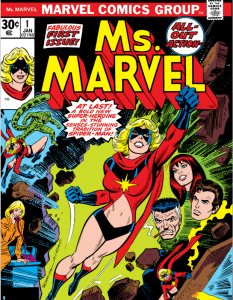
Ms Marvel Vol 1 #1:
Dec 1976
writer: Gerry Conway
Pencils: John Buscema
Inks: Joe Sinnott
colors: Marrie Severin
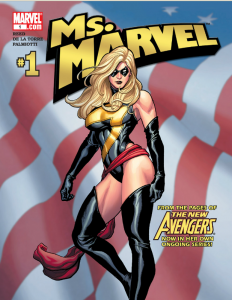
Ms Marvel Vol 2 #1
March 2006
writer: Brian Reed
inks: Jimmy Palmiotti
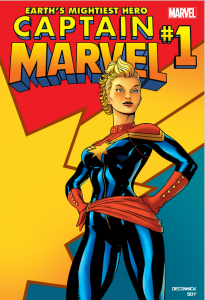
Captain Marvel #1
July 2012
writer: Kelley Sue Deconnick
All art: Dexter Soy
I thought I’d compare the issues in the following categories: costume, hair, job, reactions to Carol, and plot.
Costume
When it comes to the costume I was a bit surprised that the 1970s costume was so revealing. Her midriff is exposed and her legs are also bare. In fact, the bottom of her suit essentially resembles a pair of high cut panties. (Even though they’re really connected to the top of her suit) She wears a domino mask and regular size boots. There is no cleavage to her costume which is not surprising given the time period, but surprising to me as a comics reader in the 2010s.
The 2006 costume is more like what I [sadly] expect in modern comics. Her costume is the one-piece bathing suit design that many female supers in the Marvel universe wear (see Storm and some incarnations of Psylocke). It seems to have traded baring the midriff for such a high rising bottom to her costume that it seems to almost reach navel-level height. Her boots go to thigh length and, combined with gloves that end at the elbows – seems to be a much more sexualized costume. She still sports the domino mask; even that has been made sexier and covering less of her face. And while there is no cleavage aspect to this suit, in many of the interiors you can see “side-boob” – so Jimmy Palmiotti is not drawing it as enclosed as Frank Cho is doing on the cover. Speaking of Ms Marvel’s breasts, they appear to have grown 1-2 cup sizes in the 30 years since the previous cover.
Finally, we arrive at Captain Marvel #1. Finally, a costume we can be proud of. It looks more military like Captain America’s. It’s almost Victorian in the sense that it even goes up to her neck. Perfect for those who have been calling for an end to sexism in comic book illustration. However, it gets a bit subverted within the issue – we’ll get to that soon. Also, there is less emphasis on her breasts.
Hair
I know that hair can be intensely personal to a woman. It’s the reason behind Storm’s mohawk (90s and now). However, I only know this second-hand for I am a man. So perhaps I’m wrong in my interpretation, but I feel like Ms Marvel from 2006 is the least sexist. In the 70s, she has a haircut from that era that makes her a cute or attractive woman. In 2012 Captain Marvel has a mannish haircut. (At least it appears that way when she’s fighting and on the cover. Near the end of the book it appears it’s long and she just had it tied up or something?) I feel like the 2006 hair is just natural flowing hair. Carol Danvers doesn’t seem to care what others think about her hair while the 70s one is trying to look pretty and the 2012 one is trying to be taken seriously by males.
Job
Because, as I mentioned above, Marvel takes things on to characters rather than rebooting them, Carol’s resume grows through the decades. So in the 1970s comic she has worked for NASA (a manly job) and when she lost her ability to work there she went to be the editor of a woman’s magazine (a womanly job somewhat akin to Lois Lane’s place gender-wise). In 2006 she’s worked as a test pilot in the military (manly) , NASA (manly) , Homeland Security (manly), and as an Avenger (male/female). The latest one doesn’t make mention of all that, but it’s probably still true.
Reactions to Carol
It’s interesting to see how everyone reacts to Carol/[Ms|Captain] Marvel. I was surprised to see that despite being a woman, the criminals in the first comic take her threat seriously. Sure, they use sexist works like “dame” and all that, but they aren’t saying things like “she’s a woman, I can take her.” One of the criminals is even genre savvy – knowing he lives in a world of superheroes, he knows that women supers can be just as dangerous to criminals. (As I am adding the images to this post, I just realized that both Ms Marvel Vol 1 and Ms Marvel Vol 2 start with her throwing a car. Is the second an homage to the first?)
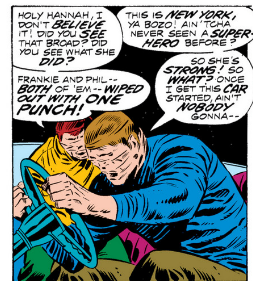
In direct contrast to that is the 2012 Captain Marvel where the villain routinely mocks her for being a woman. He asks if she’s Captain America’s secretary and whether Captain America feels like less of a man for taking order from a woman. I love the witty response – she outranks him military-wise. I know what writer Kelley Deconnick is going for here – showing what a hard time it can be as a woman. But it feels anachronistic and out of place. I felt like I would have accepted that in the 1970s comic, but it seems a bit forced in 2012. I know women still live in challenging times (making 70-90% of what men make depending on the study you read), but it’s not the butt-slapping time of Don Draper.
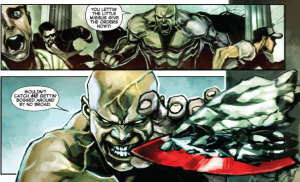
Strangely, compared to those two issues, the 2006 issue deals with the fact that Ms Marvel is a has-been and doesn’t really deal with gender issues at all. I mean Stilt Man is a B or C-list villain and he doesn’t even know who she is.
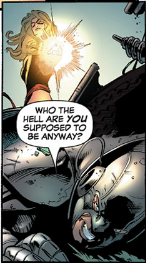
In her civilian life, Carol is dealt a series of sexist assaults by J Jonah Jameson, but it’s more in line with his character than anything else. He’s supposed to be a colossal jerk – he hates Spidey despite Spidey saving the city and his life multiple times.
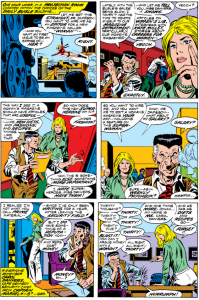
Plot
Ms Marvel Vol 1 #1 is definitely a product of its time. The plot (other than Carol Danvers figuring out that she’s also Ms Marvel) involves Ms Marvel taking on Spidey-villain Scorpion when he tries to kill J Jonah Jameson for being responsible for his miserable life. Being written during the women power time period – it’s important that she save Jameson and for him to absolutely feel emasculated by being saved by a woman super.
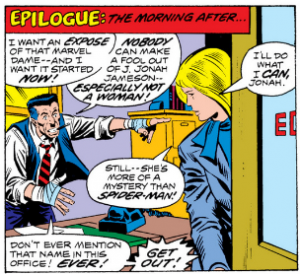
It’s somewhat sexist that Carol Danvers suffers from fainting spells which happen before she becomes Ms Marvel. I really doubt a male super hero would be written as fainting before becoming his super self.
Other than that, the issue if full of unintentional funny due to being so old. There’s too much talking instead of just showing what’s going on. Narrration boxes telling us things we can see with our own eyes. And a really weird fight in which she figures out that she got her powers from Captain Marvel and narrates all of this to Scorpion.
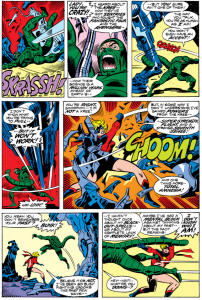
With the 2006 issue it’s nice that comics evolved to show, not tell. There’s a lot less of the panels being taken up by pointless talking “I need to use my powers to escape from this bad guy” (no crap!) I love the frame story of her having a conversation with fellow Avenger alumnus Jessica Drew. It allows for one of my favorite story telling jokes – having an unreliable narrator called out on her embellishments. I also love when super heroes do normal stuff like just eat together at a cafe. (I’ve mentioned this practically everywhere I’ve written about comics)
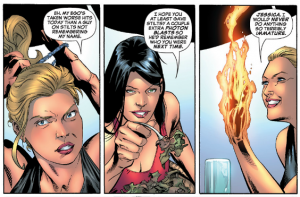
I took issue with two things gender-wise. First off, there’s this incredibly annoying tradition in comics to bend females in ways that would break their bodies in real life in order to show off their breasts and butts at all times. It has spawned a Hawkeye meme and once you start to notice this stupid practice, you can’t unsee it.
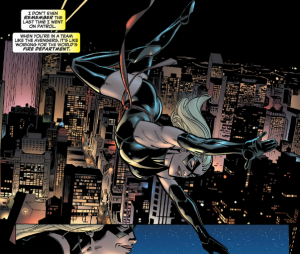
Then there’s her mention of not being able to call the Fantastic Four because she did something embarrassing with Johnny Storm in Vegas. I know this serves at least two purposes a) it makes a reference those Las Vegas ads that are still running – albeit less often and b) it makes it so she has to be there by herself. However, other than Spider-Man, I can’t see any male characters giving a crap what they did in Las Vegas – they’d call up a female super they’d hooked up with if it meant getting the job done right. In the grand scheme of things it’s not too sexist, but it just tweaks me a bit. And, as we learn in the end – it’s a Brood Invasion. The Brood are the Marvel Universe equivalent of the xenomorphs from the Alien movie franchise. She needs all the help she can get.
The final comic, Captain Marvel, is the first one written by a woman. It’s also the first time she’s called Captain rather than Ms. Now, I know there are in-universe reasons why she’s been Ms Marvel all this time. And, as the PR scene in the 2006 issue pointed out, she’s gone by other names in the past – perhaps when people realized Ms Marvel was an antiquated name. After all, other women have outgrown their sexist names – Marvel Girl and Invisible Girl, to name two.
So it’s nice to see her go to the more respectful Captain Marvel. It’s nice to see a female in a costume like the ones any man would wear. But I feel like some of that is undone with these panels focusing on her butt:


It’s disappointing considering all the other changes made. It’s like not having those poses was a bridge too far. “What do you want me to do? I made her costume less sexy! The least we can do is show her ass!”
It’s interesting comparing this issue to both the 2006 and 1970s issue. First of all, the Ms Marvel Vol 1 looks like the stereotypical comic book. The 2006 issue looks like a modern comic book. The 2012 issue looks like ART. The artwork is absolutely beautiful and more painterly than comic book-y. Also, while the 1970s issue is action-packed, and the 2006 issue ends with a Brood invasion, nothing has happened by the end of the 2012 issue. Today’s comics sure can move at a slower pace. And I’m not complaining – I think she has some great character development moments with Captain America and Spidey. Although I do complain from the sense of having a very limited budget due to my daughter being born and when you compare story density for price between a book and a comic – you can be forgiven for wanting comics to get on with it a bit.
I don’t often read comics over so many decades and with the issues that Professor Blanch has picked out we get a very nice glance at how the way we view gender has changed over the years. It’s pretty neat to see how far we’ve come and how far we have yet to go.
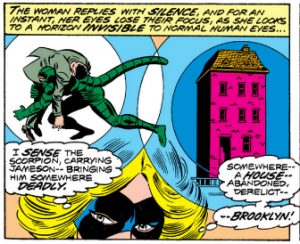
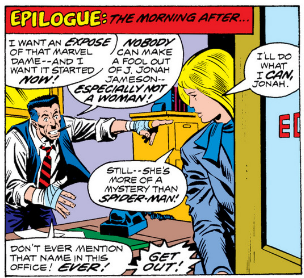
There’s another way in which the original 1970’s Ms. Marvel series was a product of its time–the character’s initial unawareness of her own past and her civilian identity as Carol Danvers. Gerry Conway, the rather ham-handed original scripter of the series, relates this to second-wave feminists’ metaphorical quest for identity in a quote cited in the Ms. Marvel Wikipedia entry (http://en.wikipedia.org/wiki/Ms._Marvel). But the initial disconnect between Carol Danvers and her Ms. Marvel persona (as I recall, for at least the first five or six issues of the original series, Ms. Marvel basically functioned like an alternate personality subconsciously generated by a person with multiple personality disorder–i.e., Carol would black out, transform into Ms. Marvel, then eventually switch back to Carol with no idea of what had happened or what she’d been doing in the interim) followed in the “super powers as an expression of multiple personality” footsteps of at least three previous Golden and Silver Age female costumed characters. These are the Golden Age villainess known as the Thorn, who was portrayed as a case of mostly magic-induced split personality (see my 2007 *Sequential Tart* article “Supervillainesses in Love” [http://www.sequentialtart.com/article.php?id=554] for details); the Silver Age Enchantress/June Moone, a young woman who, unlike the Golden Age Thorn, displayed no previous psychological tendencies toward fragmented identity, but wound up saddled with a much more dominant, extremely magically powerful–and increasingly difficult to control–alternate personality as a result of an encounter with a vaguely Shazam-like being (http://en.wikipedia.org/wiki/Enchantress_(DC_Comics) ); and Rose Forrest, the title character of the DC Comics strip “Rose and the Thorn,” which ran in the back of the Lois Lane comic book in the early 1970’s (http://en.wikipedia.org/wiki/Thorn_(comics) ).
By day, Rose was the meek blonde daughter of a hero cop who’d been killed in the line of duty. But when she fell asleep, her rage-filled subconscious took over, leading her to don a red wig and a skimpy green costume in order to pursue a vaguely Punisher-esque quest for revenge against the mobsters of the organized crime cartel The 100, whom she held responsible for her father’s death.
Like Carol Danvers, Rose Forrest remained unaware of her alternate persona and its activities for much of the series. I’m uncertain if this was actually the case with the Golden Age Thorn or June Moone/the Enchantress. But the common thread of two personas working at extreme cross purposes within one woman–which in real life generally winds up being diagnosed as a mental disorder–is definitely echoed in Conway’s portrayal of Carol’s unawareness that she is also Ms. Marvel, and in her resulting fears about her recurring fugue states and the potential implications regarding her mental health.
There’s also another Marvel superheroine created around this same time or shortly thereafter who is explicitly identified as suffering from multiple personality disorder. This is Alpha Flight member Aurora, Northstar’s twin sister, whose original personality, Jeanne-Marie Beaubier, is an extremely timid, submissive, prim and proper young woman. Her super-powered Aurora persona, on the other hand, is bold and adventurous (both sexually and in the superheroic sense) and regards her “parent” Jeanne-Marie persona as a wet blanket to be avoided at all costs. (This sentiment is reminiscent of the disdain She-Hulk at one point developed for her much more ordinary original persona as merely human attorney Jennifer Walters. However, since She-Hulk’s personality is essentially a more exaggerated and uninhibited version of Jennifer’s, rather than its polar opposite, as with Aurora and Jeanne-Marie, this falls more within the realm of standard human inner conflict, rather than literal warring alternate personalities.)
All this suggests that, at least up through the 1970’s, there was still such a strong perceived contradiction between femaleness and superhero-style empowerment that a number of comics creators wound up portraying super-powered female characters in a manner that implied that, for a woman, with great power comes great mental instability, if not actual multiple personality disorder. This tendency has also resurfaced more recently in Bendis’ treatment of the Scarlet Witch in “Avengers Disassembled” and subsequent storylines, although in this case amnesia/multiple personality disorder has played a much more minor role.
In the post-“Avengers Disassembled” “Young Avengers: The Children’s Crusade” maxiseries, a Scarlet Witch lookalike found living in Latveria is eventually revealed to be the amnesiac Wanda Maximoff, who at that point has no recollection of being the Scarlet Witch or even of being a mutant. But this plot element pales in comparison with Wanda’s earlier portrayal by Bendis as having become so unhinged by her own reality-warping powers that she falsely believed she had magically given birth to twin babies fathered by her android husband the Vision (even though it was more recently retroactively revealed that the children in question somehow do genuinely still exist) and homicidally lashed out at many of her fellow Avengers when this delusion was inadvertantly challenged.
That’s a pretty awesome interpretation. I’m glad you decided to comment – thanks for the long post.
You got me thinking – I wonder if it’s also a metaphor (whether the original writers intended this or not) of the mother in the workplace. Women in the 70s and 80s had to be man-like to be accepted in the workplace (hence the shoulderpads) and, as you mention, the super hero personas were more manly (in the sense of violence and muscles). But in her civilian life (as a mother at home), she is a more conventional woman. Although Carol Danvers was enough of a strong woman to tell J Jonah Jameson which features she would and would not do.
As for the Scarlett Witch story – I wonder if it can be read as more of a “magic has consequences” parable. Like if you’re constantly rearranging reality, would your grasp of reality slip. Also it led to the great House of M and the years of great X-Men stories that just ended with Avengers vs X-Men.
I don’t know how familiar you may be with the infamous Avengers #200 story (described in vehement detail in Carol Strickland’s article “The Rape of Ms. Marvel” [ http://www.carolastrickland.com/comics/msmarvel/index.html ], referenced in the Ms. Marvel Wikipedia article), in which Ms. Marvel winds up inexplicably giving birth to an apparently full-term baby after a mere three days of pregnancy, with no recollection of how she got pregnant in the first place. Later in the issue, it is revealed that Carol had been whisked off to some sort of other-dimensional limbo by Marcus, the half-human son of the time-traveling villain Immortus. There Marcus, believing that he could only safely exit Limbo or visit Earth by being reborn here, seduced and/or brainwashed (depending on your interpretation) Carol (who happened to look just like the long-lost human woman Immortus had seduced–or whatever–years before in order to produce Marcus in the first place) into becoming his lover just long enough to get her pregnant. Marcus then wiped Carol’s memory and dumped her back on Earth, where she somehow gave birth to a supposedly-more-compatible-with-our-dimension infant version of Marcus in Avengers Mansion three days later.
The newly reborn Marcus then proceeded to mature to adulthood within twenty-four hours or less. When he eventually explained his entire backstory to Carol and the assembled Avengers, everyone–even Carol herself, who had previously been distraught and indignant at the obviously questionable, albeit at that point unknown, circumstances behind her mysterious pregnancy–improbably reacts by finding the situation romantic rather than rapetastic (or at least ethically dubious). The bizarre story ends happily(?) with the suddenly adoring Carol (who had previously rejected the baby as a “thing” thrust upon her without her consent) voluntarily returning to Limbo with her son/lover Marcus to resume their dub-con–and presumably now-incestuous–romance. At least until famously feminist scripter Chris Claremont revisited the incident in an Avengers Annual a year or so later, in which Carol returns to Earth deeply embittered over the entire Marcus incident and the Avengers’ unquestioning acceptance of Marcus’ behavior, despite its dubious consensuality and its drastic impact on their at least partially brainwashed teammate.
My point in rehashing this improbable sequence of events is that although Carol is, in fact, technically a mother by virtue of having been inveigled into giving birth to the Earth-dimension version of Marcus, which may have inspired your working-mother analogy, Marcus then grew to adulthood within a matter of hours, and was largely ignored by the traumatized Carol until he became full grown and implausibly won everyone’s hearts by explaining how he himself had brought about this situation. So Carol didn’t raise him or spend any length of time functioning in any meaningful sense as a working mom. Even if her post-childbirth/pre-revelation-of-how-it-all-happened reaction hadn’t been to reject the offspring in question entirely, the reborn Marcus’ “childhood” lasted all of one day, if that.
At the end of the Avengers #200 story, Carol was pretty much written out of the Marvel universe entirely until Claremont brought her back. His drastically revisionist take on Carol’s brush with motherhood appears to have made the squick-inducing nature of the Marcus incident so embarrassingly obvious to everyone at Marvel that, as far as I am aware, Carol’s problematic status as a parent (however bizarrely and technically) has not been alluded to since. So no, I don’t think the split between the more physically powerful and aggressive Ms. Marvel and the relatively conventional (in the sense of not doing anything more violent than telling off J. Jonah Jameson) civilian woman Carol Danvers works as an analogy for the contrast between the two faces presented to the world by mothers attempting to balance work with family and/or some variant of the traditional female role. Especially since Carol didn’t (sort of) become a mother until the ’80’s, years after her amnesiac/pseudo-split personality period was over. Not to mention the fact that, far from being depicted as the kind of conventionally feminine, presumably fond of children Silver Age-type heroine typically created by Stan Lee in the 1960’s, Carol had initially been introduced to the Marvel universe in the pages of the male Captain Marvel’s comic as a tough-talking NASA security chief–a stereotypically “manly” profession (especially in the early 1970’s) that doesn’t exactly suggest hidden depths of longing for a more standard feminine role.
It’s true that the three earlier dual-persona’d female characters I mentioned in my original post–the Golden Age and 1970’s Thorn and June Moone/the Enchantress–did have much more conventionally feminine, “girly” personalities in their non-super/costumed identities. But Carol Danvers actually started out being portrayed as a tough woman planning on a lifelong career in the military (an ambition that was apparently derailed by the many reputation-damaging security breaches related to the Kree Captain Mar-Vell’s activities on and around the air base she was supposed to be keeping secure). So the main difference between civilian Carol and Ms. Marvel in her early amnesiac/dual-personas-unaware-of-each-other period was that Ms. Marvel was a lot better equipped to physically kick ass–and knew it, unlike the unwitting (but still fairly formidable personalitywise) Carol Danvers.
I’ve heard of that story – it’s pretty messed up. I was speaking of her being like a mother more metaphorically than referring to that story (which I’d forgotten until you brought it up).